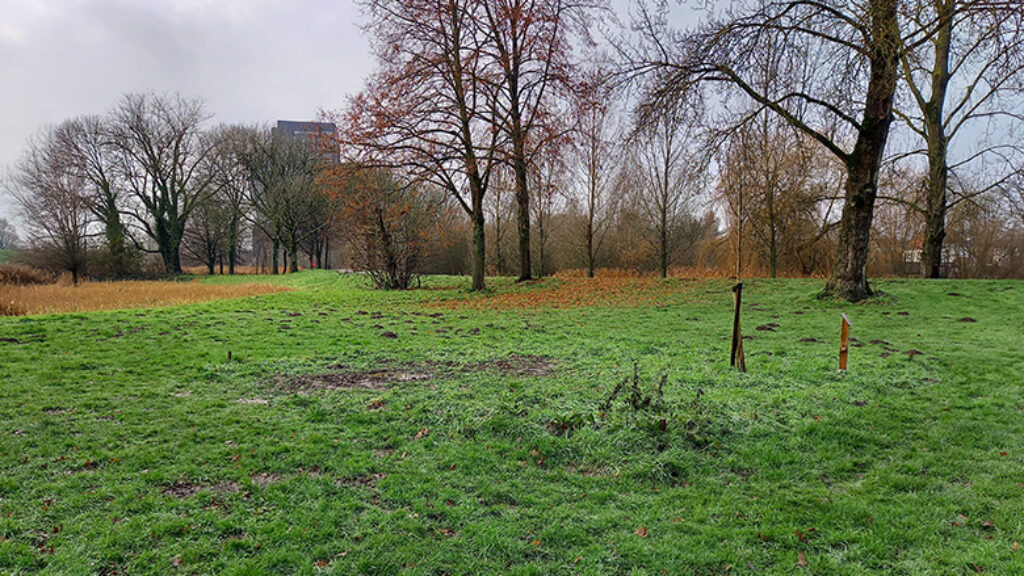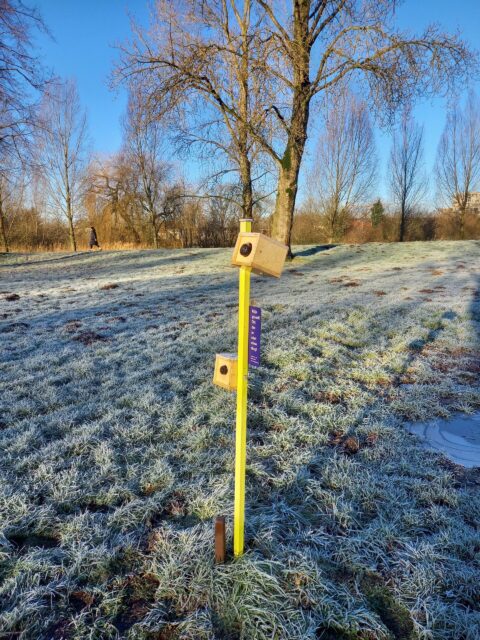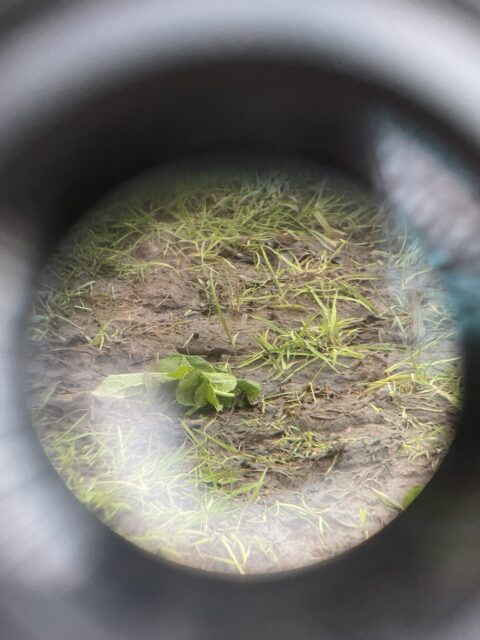14 April 2023
Article
49m2, year 7, winter 2023 | There is something to see in Zaartpark

There is something to see in Zaartpark
“Things are exactly what they are, but never what they seem.” – Timothy Morton – Anne Leijdekkers
The events in life that leave the strongest and most enduring memories are often, in some way, framed. A thick golden frame around a painting tells us that what happens within is important and worthy of our attention. In much the same way, the significant moments of life carry a golden aura that lifts them out of the everyday: birth and death have long been surrounded by rituals, distant journeys are placed on the pedestal of the strange and the new, and when we experience something for the first time – a city, a lover, a feeling – it becomes the benchmark for all experiences that follow.
But there are also memories that only gain weight in retrospect. Memories of moments when you wandered through life with your soul under your arm; memories of things you didn’t even notice at the time, moments that never rose above the dull hum of daily life. And even afterwards, you can’t help but admit: this memory doesn’t really matter – it’s a banal triviality. And yet, it keeps resurfacing to say: Hey, remember that one thing, that one time, that meant nothing and changed nothing? Just letting you know – it’s still here, and it still hasn’t changed anything.
One such memory for me is of a newspaper article I read over ten years ago, on a sunny Sunday morning (which was, in truth, already well into the afternoon). The article reported complaints from a group of funfair operators about old men, often retired construction workers, who would turn up wherever the fairground attractions were being built. Nobody likes to be watched while they work – but if these men had just stood there quietly, there’d have been no story. The problem was that they also had ideas and opinions, and from the sidelines they constantly offered comments and suggestions to the workers assembling the rides – all while keeping their hands neatly clasped behind their backs.
I’ve never been to a fairground, and I’ve since read hundreds, if not thousands, of articles – all of which I’ve forgotten.
Spectators, bystanders, meddlers
The problem of meddling bystanders is not unique to Dutch carnival workers. In Bologna, the phenomenon is so common that it has its own name: umarell – loosely translated as “little old man”. While not universally applicable, the stereotype that men can’t help but interfere isn’t without basis. Like the Dutch fairground operator, the Bolognese construction foreman is harassed by the unsolicited stares and comments of old men who find it easier to keep their hands behind their backs than to keep their opinions to themselves.
Because I have my assumptions about Witte Rook’s readership, I’ll go out on a limb and guess that everyone reading this has looked at art at some point. Another assumption: not everyone reading this is a retired man. And yet, I believe we can all consider ourselves a bit of an umarell, because there’s not much difference between watching construction work and forming an opinion, and looking at an artwork and having thoughts about it. Leonard Cohen once said that a poem should be read dryly, like a shopping list. A love poem doesn’t need to explain what love is – just say what you have to say, and trust that the one listening has the life experience to understand. In other words: the artist may – must! – assume that their audience is made up of retirees from a lifetime in the subject.
In preparation for her residency, Anne positioned herself as a kind of contra-umarell. In Zaartpark, next to the 49m2 that would be her working space for the coming weeks, she unfolded her chair and sat watching the passing walkers, joggers, strollers, sniffers, cyclists, daydreamers and those in a hurry. Her aim was to observe how people respond to this small free state of the visual arts, located in a park where they might walk their dog daily or cut through only occasionally on the way to some appointment in the outskirts of Breda. I call Anne a contra-umarell because, unlike the original, she was perfectly capable of observing without commenting. I also call her contra because she was watching those who were themselves watching: she was looking at the lookers.
And, as if to prove my hypothesis that everyone who engages with art is, deep down, a retired builder, Anne discovered that people’s attention was drawn not to the artwork she sat beside, but – how could it be otherwise – to a construction site. Or, more accurately, a demolition site. Across from the grassy plot in Zaartpark, workers in helmets and hi-vis jackets were busy tearing down a hospital. For minutes at a time, people stood and watched as walls were battered, steel beams pulled down, concrete crushed. Poor visual art was no match for such spectacle.
So how do you get people to look? How do you even give them the chance to look? You could try placing something even grander beside the grand – but Anne’s space was limited to exactly 49m2, and that doesn’t stack up to a hospital complex.

Photo Anne Leijdekkers
Looking far
When I visit Anne on an icy, rain-soaked day, I struggle to find her and the work. Water levels across the country – and in the park – are ominously high, and for a moment I wonder whether the work has simply flooded. Scanning for a trace of art above the surface, I eventually find Anne and the piece on dry (albeit soggy) land. It turns out the reason I missed it is simple: there’s not much to see. At the edge of the modestly cordoned-off patch of park stands a post with two field binoculars attached. Before walking up to the installation to look at – and through – the binoculars, I too am momentarily distracted by the neighbouring hospital ruins. “There’s going to be a sign,” Anne says, “it will read: Look closely! This isn’t something you see every day!”
Looking closely – that’s precisely what the umarell loves to do! And the binoculars give us every chance. Even with a magnificent demolition site just a stone’s throw away, the binoculars help to shut out everything in your peripheral vision, leaving only the act of looking. But now that we’re finally able to look undisturbed, the question immediately arises: what are we actually seeing?
That question brings us, yet again, to an old Italian man who liked to share his way of seeing with others: Galileo Galilei. He’s best known today for his clashes with the Church over whether the Earth moves or stands still. Less well known, but equally influential in shaping modern ways of thinking, is the scientific debate around the telescope. Galileo was one of the first scientists to use a telescope to study the heavens, and what he saw raised just as many questions as answers. We should remember that the newly invented telescope offered a radically different view of the world – and that by using it, Galileo literally saw things differently.
So what questions and answers do the binoculars in Zaartpark provoke when we look through them? The answer is: few answers, many questions. Those who leave the path and make the journey to the binoculars are likely to be underwhelmed at first: they show the same poorly maintained grass you could already see with the naked eye – only slightly larger. The biggest question that emerges is: what did the artist see? Does the artist view the world differently from us? Did she see something here that remains hidden from us, even when she puts our noses (or rather, our eyes) right up to it? Anne’s favourite quote comes from Timothy Morton. It appears on her website (under the “about” section) and she repeats it a couple of times in our conversation. It’s the quote I took from her website to begin this piece: “Things are exactly what they are, but never what they seem.” So, looking through the binoculars, Morton in hand – what did Anne see that we don’t?
Nothing.

Photo Anne Leijdekkers
Nothing is not nothing
It may seem that Anne is showing us nothing. But if things are not what they seem, and yet exactly what they are, then what appears to be nothing is, in fact, something. If nothing is what it seems, then anything that seems like nothing must be something.
It’s winter, and I’m standing in a park in Breda. Rivers, ponds and canals are overflowing; a stormy wind bends the trees to dangerous angles; beside me, a building complex where people once healed or died is being torn apart piece by piece – and what am I looking at? I’m staring, up close and with full concentration, at nothing – a patch of grass, a puddle of rainwater, some mud. Amidst all the things around me that are something, I’m looking at something that appears to be nothing – in other words: I’m simply looking at what is. And maybe simply looking at what is, is precisely what it means to truly see what is.
After our visit to the artwork, Anne and I wander and talk for a long time. A recurring theme is the idea of disappointment. Not disappointment in the sense of grand expectations left unfulfilled, but the idea that artworks can sometimes disappoint because you go to them expecting answers – only to realise that you were asking the wrong question.
Why have I spent more than ten years remembering a moment of nothing? A memory of a short article about funfair workers and retired builders? Am I disappointed about that? Yes, in a way. There are many things I wish I remembered instead of that article. But that disappointment is the umarell in me, watching from the sidelines, always having an opinion – and forgetting to look at what is. Art is often more about seeing than looking: what do you see? how do you see it? Seeing cannot exist without something, just as the umarell cannot exist without something to comment on. Looking, on the other hand, can happen without an object. What are you looking at? Oh, nothing really – a field, a hospital, that person walking their dog, just… whatever.
Looking closely – that’s not something you see every day.
Roel Neuraij, April 2023
